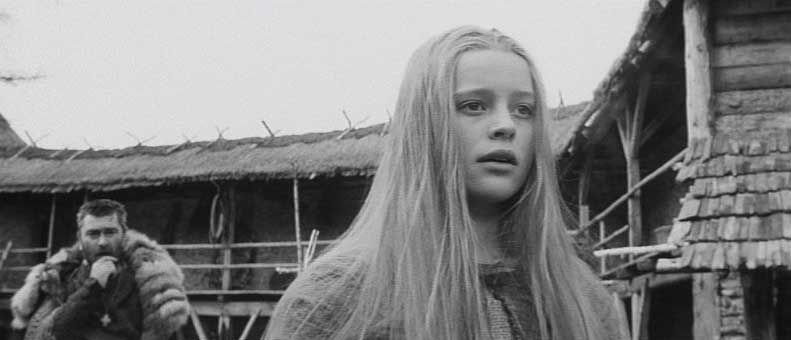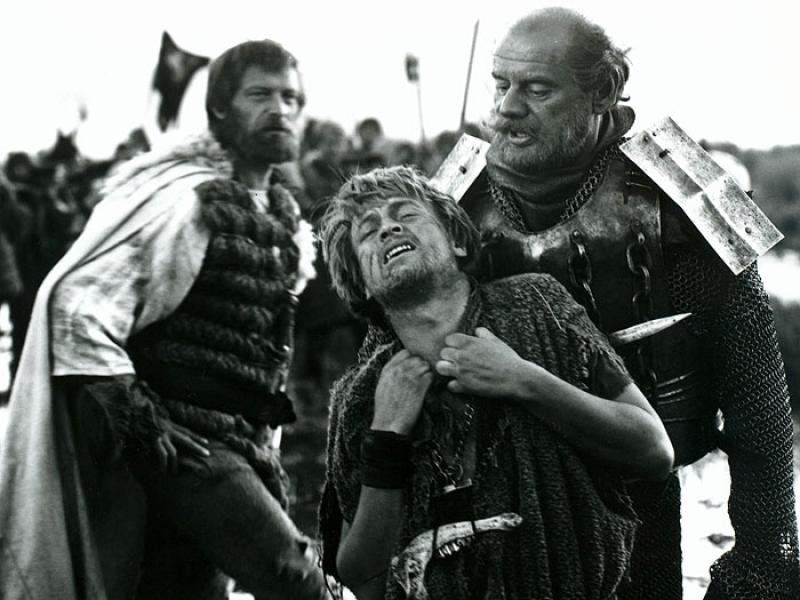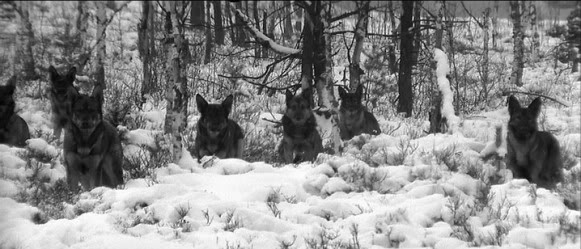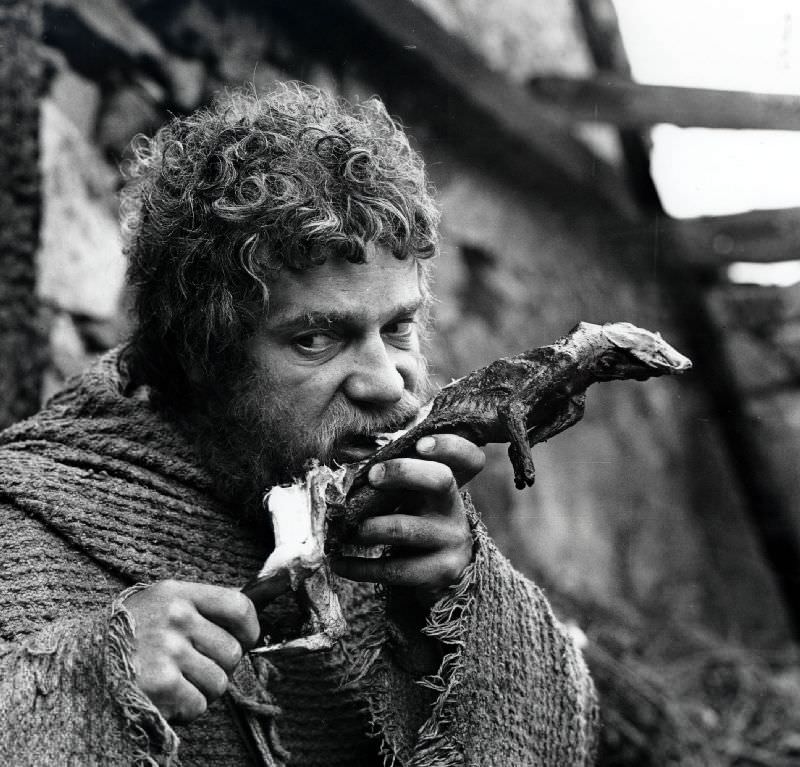František Vláčil’s Marketa Lazarová (1967) is a virtual terra incognita. Thirty years after its release, it was named overwhelmingly by a poll of Czech critics and filmmakers as the best movie ever produced in Czechoslovakia, yet it remains little known outside its native land. Even as national epics go, Marketa Lazarová is unusually off-putting to outsiders. Violent and anti-heroic, the movie opens on a note of mordant self-deprecation (“This tale was cobbled together and hardly merits praise”) and goes on to represent thirteenth-century Bohemia as a backwater of Conan the Barbarian’s Hyperborean Age—the province of halfwits, rapists, and brutes.
Aside from repeated, if intermittent, screenings at the Brooklyn Academy of Music (and a relatively recent Vláčil retrospective at the Film Society of Lincoln Center), the movie has hardly been shown in the United States since its 1974 American release, for which it was shortened by over an hour. (Supremely unimpressed, The New York Times at the time characterized Marketa as “a colossal—and very near interminable—hodgepodge of medieval mayhem and myth, leaden symbolism and bloated piety,” featuring characters of “such unmitigated savagery that next to them the Visigoths would resemble a Red Cross mercy mission.”) Now released as a Criterion DVD in its full 165 minutes, Marketa Lazarová may finally reach a wider American audiences in all its sprawling glory.
Certainly, the film has an impressive pedigree. Vláčil adapted his labor of love from a 1931 novel by Vladislav Vančura (1891–1942), an expressionist Czech writer, avant-garde activist, independent filmmaker, and (per the movie’s credits) “people’s artist.” In addition to being a pre-war Communist (though he was expelled from the Party in 1939), Vančura was also a wartime martyr, one of many Czech partisans who were executed in reprisal for the assassination in Prague of Reichsprotektor Reinhard Heydrich.
Vančura’s Marketa Lazarová is a mock epic, depicting the savage feud between two rival brigand families, the pagan Kozlíks and nominally Christian Lazars, in the wilds of medieval Bohemia. Vančura was an almost untranslatable master of word play, and here invented a new Czech idiom, at once modernist and archaic, to create, in effect, a new shared geneology. The Czech writer and film historian Josef Škvorecký called Vančura’s lusty yarn a “novel of momentous importance in the history of Czech literature.” Evidently, the novel also had much to say to the young, multinational state that was interwar Czechoslovakia; despite its avant-garde underpinnings, it was his most popular and commercially successful work.
Vláčil’s film treatment is more universal. Sumptuously black and white, Marketa Lazarová unfurls in widescreen panorama, accompanied by the music of keening chorales, tolling bells, and a constant, subliminal muttering. The resulting art-house spectacular owes something to the stark medieval mise-en-scène of Ingmar Bergman’s The Seventh Seal and somewhat more to the ferocious sweep of Akira Kurosawa’s Seven Samurai.
In the movie’s first scene, the Kozlíks ambush a Saxon nobleman and his retinue, murdering all except for a young man, who is taken captive as a sex toy for the family’s sole woman, the lupine Alexandra. Old Lazar, meanwhile, has promised his daughter Marketa, introduced cradling a dove between her breasts, to a convent, presumably in expiation for his sins. (Magda Vášáryová, the actress who played the wide-eyed, innocent Marketa, grew up to be a noted liberal Slovak politician.) The Lazars have benefited from the Kozlíks’s exploits but when they decline to aid their partners in crime against the local military commander the alliance explodes. The Kozlíks attack the Lazar stronghold; midway through the movie, Old Kozlík’s renegade son Mikuláš crucifies Old Lazar and rapes Marketa, carrying her off as Vláčil’s camera launches into a sympathetic frenzy.
Set in the spring, the movie’s second half introduces a half-mad monk (not found in Vančura’s novel) who travels the countryside in the company of an ewe. Although the movie builds in richness through a number of purposeful repetitions, the action now seems faintly absurd. As in a Shakespeare comedy, the characters are forever wandering lost in the forest. Marketa has not only submitted to but also come to love Mikuláš. Nevertheless, she follows a sacred stag back to the convent, only to be shunned by the hypocritical nuns. Mikuláš marries Marketa on his deathbed and the movie ends with the narrator noting that both Marketa and Alexandra have given birth to sons… the progenitors perhaps of the Czech people.
A trained art historian who began his movie career under the auspices of the Czechoslovakian military, Vláčil made Marketa in a manner both showy and ambitious. The compositions are often mystical arrangements—a formation of expectant wolves is a recurring motif. The camera placement is strategically off-kilter when static; more often, however, Vláčil’s camera is roaming, lurching, and sometimes spinning around the countryside. (That the movie’s first half is largely staged in the snow makes these tracking shots all the more impressive.) The montage can be casually atemporal, interrupting the action with bursts of symbolism—or inexplicable kitsch.
Advertisement
Marketa Lazarová is easy to watch but difficult to follow. The film has affinities with Andrei Tarkovsky’s medieval epic Andrei Rublev (1966)—as well as Sergio Leone’s Italian westerns; in fact, it was a parallel development that drew inspiration from the same filmmakers and support from a similar socialist funding system. Indeed, as the Czech film industry’s costliest production, taking three years to make, Marketa was not simply a national epic but, like Andrei Rublev and certain Polish extravaganzas (Wojciech Has’s Saragossa Manuscript, Andrzej Żuławski’s On the Silver Globe), the sort of avant-garde folie on which East Bloc national film industries intermittently lavished support.
For the first fifteen years of Communist rule, Czech historical films, with few exceptions, were concerned either with the fifteenth-century Hussite Revolution or the leading personalities of the nineteenth-century Czech national revival. Marketa Lazarová is something else entirely. Its filming coincided with the mid-1960s political thaw in Czechoslovakia and ensuing tumult that would bring the reform Communist Alexander Dubček to power in January 1968, scarcely three months after the movie’s release. For all its outrageous primitivism, and brutality, Vláčil’s mad epic was a harbinger of the Prague Spring and undoubtedly, during the course of the long winter that would follow, a reproachful embodiment of its blighted hopes. It is a movie made without regard to political politesse or cinematic decorum. Small wonder that contemporary Czech critics regard it with such awe—it’s evidence of the psychic liberation that was stifled by Soviet tanks.
While I cannot entirely unpack its political subtext, Vláčil’s movie is clearly an example of what might be termed “method” directing—acting out the movie that one makes. (Werner Herzog personifies this approach, although Coppola’s Apocalypse Now, which required that the filmmaker provoke a spectacular catastrophe in order to dramatize the Vietnam War, is the mode’s most vivid example.) In an interview given soon after Marketa’s release, Vláčil explained that he prepared for the movie by studying Stone Age cultures and then, over the years required to make Marketa, by submitting to their ways of life: “Every detail, starting with the nails, had to be made for the film. I had most of the props—tools, weapons, etc.—made not with modern equipment, but the way they were probably manufactured in their times.”
Vláčil brought his cast to the Šumava forest in southern Bohemia. In Peter Hames’s history of the Czech new wave, he’s quoted as saying that “there we lived like animals, lacking food, and dressed in rags.” And there, according to Škvorecký, Vláčil was “seized by the same madness as his medieval highwaymen.” He shot “endless miles of footage; the film swallowed millions… Vláčil deteriorated, reinforced himself with alcohol, and broke down. He turned into a bearded skeleton.”
Škvorecký has called Marketa Lazarová “the most beautiful and wild spectacle on all of Czech cinema.” Others, notably film historians Mira and Antonin J. Liehm, are less taken with it. After the movie’s canonization, Zuzana Slobodová published a dissenting opinion in the Central Europe Review, calling it an overly morbid, humorless adaptation of Vančura’s novel. That’s an evaluation that non Czech speakers are ill-equipped to make although, as noted in the DVD’s accompanying booklet, Alex Zucker is working on an English translation that may supplant a cinematic masterpiece with a literary one.
Marketa Lazarová is now available from the Criterion Collection.






